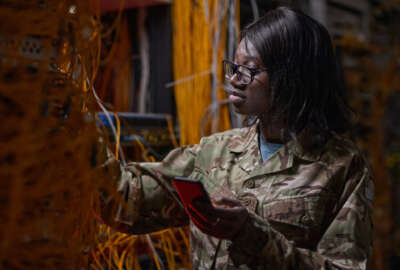
Army ready to ask vendors to help build its vision of a ‘unifed network’
The Army is planning a significant multiple-award ID/IQ to tie the communication advancements it's achieved at the tactical edge into a more manageable structuring...
The Army has been talking for more than two years about the concept of a “unified network” to simplify its battlefield information technology. Now, officials are ready to ask for industry’s help to make the concept a reality.
By this fall, the Army intends to issue a major solicitation for a multi-year, multiple-award contract to start implementing unified network operations (UNO), with an emphasis on a modular, software-intensive architecture.
Although the UNO program is expected to be a significant IT procurement, there are still several steps the service needs to finish before it arrives at a cost estimate. The acquisition process started in earnest last Wednesday, when the Army published a request for information querying vendors about their capabilities, accompanied by a first official draft of the performance of work statement for the UNO program.
The basic idea behind UNO is to break down stovepipes on the Army’s current battlefield network, and to reduce the cognitive load on soldiers who have to employ the disparate systems that make up that network.
The Army thinks it’s made massive strides in bringing new communications technology to the tactical edge in recent years, but actually putting those advancements into practical use has come along with a lot of needless complexity for its signal corps and the end-users they support.
“The problem is that the soldiers now have to learn different user interfaces, have to reach for a tool, and understand how the tool works whenever they want to do a specific function,” John Kantonides, the chief engineer for the Tactical Cyber and Network Operations (TCNO) product office, told attendees at an Army technical exchange meeting in Nashville last month.
Often, Kantonides said, the current state of affairs means soldiers also need to manually load data that they’ve received on compact discs or via email into a multiplicity of individual systems — and make sure to save it in exactly the right directory — in order for that tool to do its job.
“That is not a vision going forward, and that’s not achievable,” he said. “We don’t want the soldiers to know about tools anymore. All they want to do is get through their task-oriented workflows, and make sure everything they can do is there.”
So the Army wants a common graphical user interface to sit atop all of those tools. Besides that, the UNO program will need to tie those systems — and their data feeds — together in a way that lets new capabilities be quickly added to the network, so tactical-level network operators can manage each of the endpoints in their formations without needing to worry about the technical details of what’s happening behind the scenes.
“This is a software-centric program, and we’re going to move as rapidly as possible to design, develop and incorporate new features and updates into the unified network,” said Lt. Col. Keith Jordan, the TCNO product manager. “We have a vision of getting to that endpoint management through a singular, simple to use interface. Just like on our iPhones, when there’s an update pushed, you don’t really see much of a difference in the interface. We want to maintain that singular interface, even if, in the background, vendors may bringing new capabilities on, we’re moving capabilities off and we’re making security updates. Right now, our signal soldiers are managing so many end user devices that oftentimes we’re not getting that best data and information to the commander to make better decisions. So this is a way to help us do that.”
The Army plans to do that through a framework based on the open-source GraphQL specification, with microservices and middleware sitting between each of its various tools and a central GraphQL server. Aside from developing the GUI itself, creating the middleware that will structure each tool’s data feeds into a common data schema will be one of the first tasks the UNO program will ask industry to tackle.
Kantonides said the Army settled on the GraphQL approach after consulting with the Johns Hopkins Applied Research Laboratory, which tested the concept in laboratory-based scenarios using existing Army systems.
Officials like the GraphQL approach for at least a few reasons: Since the query language is open source, it drastically reduces the chances that the Army will fall victim to vendor lock once it picks a contractor to develop the middleware; it’s being widely adopted by the commercial IT industry; and it’s highly adaptable to existing data feeds.
“It gives us an infrastructure and an architecture that that we can build on – it’s not an all or nothing thing,” he said. “We can start slowly integrating capabilities in, and as we grow, we start bringing in microservices, we start bringing in functionality to deal with very specific functions. There are going to be a lot of new things that come up that need to be integrated into the program so it can be managed, provisioned and secured in a proper way.”
Once the Army gets feedback from the RFI it issued last week, it plans to issue a draft request for proposals in the spring. From there, officials hope to move fairly quickly, and publish a final request for proposals by late this summer or early fall.
The Army plans to structure the UNO program as a multiple-award indefinite-delivery/indefinite-quantity contract lasting for six years, starting in late fiscal year 2024. The first planned task orders will be for the development of the middleware needed to make the system work, and for the graphical user interface, including training focused on making that GUI easy to use.
From there, the Army will move on to task orders focused on delivering UNO to smaller formations at the battalion level and below, and developing an identity management infrastructure for the new program.
First though, the Army will need to get formal signoff for each aspect of the UNO program through its requirements approval process. Much of that work has already been done, and officials expect the Army Requirements Oversight Council to complete the process in the next few months.
But when it comes to requirements and funding for future years of the program, the Army has already made some strides toward simplicity.
In December, Gabe Camarillo, the Army undersecretary, signed off on changes to the Army’s programming, planning, budgeting and execution (PPBE) processes that should let officials move IT investments through the requirements and spending approval pipelines much more quickly.
Dr. Raj Iyer, the Army chief information officer, said the new “digital resourcing framework” will have major effects on a wide range of the service’s IT investment planning processes, beginning with about $5 billion of the IT dollars the Army will spend in fiscal year 2025.
Iyer said the framework, as it’s currently imagined, will eventually lead to a single program evaluation group (PEG) for “digital” matters, replacing the multiple PEGs that currently must sign off on IT investments.
“We’ve been stovepiped with our budgeting, and it’s been managed by a billion folks who don’t understand the strategy and who may not have the technical expertise to make decisions,” Iyer said. “Starting in 2025, the CIO, the G-6 and other stakeholders in the Army will now lead prioritization of requirements, and the balancing of those requirements against available resources for about 25% of our [IT] budget. That will continue to grow in scale in 2026 and beyond. What that means is we now have the ability to manage our requirements, prioritize them the right way, balance competing interests in a way that’s threat informed, and that’s the way to do this. These are huge, huge gains in terms of making sure that we have the right resource management goals.”
Copyright © 2025 Federal News Network. All rights reserved. This website is not intended for users located within the European Economic Area.
Jared Serbu is deputy editor of Federal News Network and reports on the Defense Department’s contracting, legislative, workforce and IT issues.
Follow @jserbuWFED





